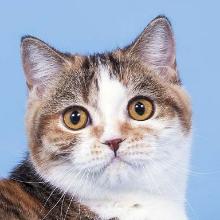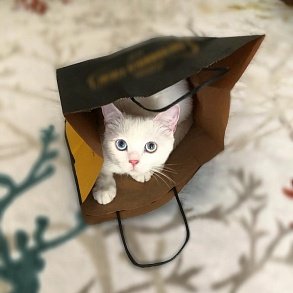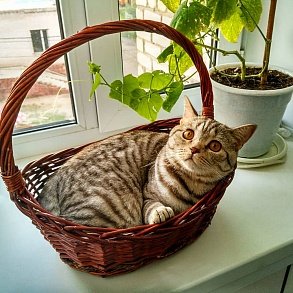Scottish straight-eared cat

The Scottish straight-eared (Scottish Straight) is a breed of calm and serious domestic cats that are closely related to Scottish folds.
- Brief information
- Highlights
- Breed characteristics
- History of the Scottish straight-eared cat breed
- Appearance of a Scottish straight-eared
- The character of Scottish Straight
- Training and education
- Care and maintenance
- Health and diseases of the Scottish straight-eared cat
- How to choose a Scottish Straight kitten
- How much does a Scottish straight-eared cat cost
Brief information
- Breed name: Scottish straight-eared cat
- Country of Origin: UK, Scotland
- Weight: 4-7 kg
- Life expectancy: 12-15 years old
Highlights
- Scottish straights do not require increased attention to their own person and do not perceive the absence of the owner as a catastrophe of universal scale.
- Representatives of this breed do not share spheres of influence with other pets and are loyal to dogs.
- Easily assimilate the norms of cat etiquette: torn wallpaper on the walls and striped sofa upholstery is not about the Scots.
- Many individuals are quite passive. They love to immerse themselves in themselves and contemplate the surrounding reality, rushing away somewhere far away in their thoughts.
- Are stress-resistant and get used to a new environment relatively quickly.
- Scottish straight-eared cats are characterized by a fear of heights, so these pets almost never climb above the table.
- Smart and independent. They always achieve their goal.
- Scottish Straights are incredibly photogenic. Any photo on which fluffy cute guys managed to "light up" automatically turns into a sample of mi-mi-mishnost.
- The favorite toy of the Scottish straight–eared cat is a feather teaser. She can drive such a treasure around the apartment for hours.
- Scots need affection and tactile contact, but categorically do not tolerate being picked up.
Scottish Straights - serious plush intellectuals who do not tolerate familiarity, but are able to create an atmosphere of comfort and peace in any place, wherever they are. As true Scots, they prefer not to show their own emotions to anyone, choosing only a proven person for this "sacrament". However, even in this scenario, the Scottish straight-eared manage to remain one of the most charming and soul-sinking cat breeds, yielding in popularity except to their closest relatives – lop-eared scotties .
Breed characteristics
History of the Scottish straight-eared cat breed
Scottish straight–eared are the same Scottish folds, but with a modified position of the auricle. Straits' ears do not have a characteristic crease and are set straight, and this is, in fact, the only external sign that distinguishes them from their lop-eared counterparts. Scotties are considered one of the youngest cat breeds. The first cat with an unusual, flattened shape of ears appeared on one of the Scottish farms in the early 60s. Surprisingly, the progenitor of modern folds and straits did not have a pedigree and simply drove mice through the barns of local peasants.
The first official breeder of the Scotties was an ordinary villager, William Ross, who took a kitten from the aforementioned lop-eared mousetrap. And a few years later, professional breeders joined the process. At the same time, experts witnessed an interesting phenomenon: in litters brought even by the purebred Scotties, no, no, and babies with erect ears appeared. Of course, no one was going to single out such individuals into a separate breed. And kilometer-long queues for straight-eared kittens were not lined up, because against the background of touching folds, they frankly lost. But then nature itself intervened.
Very soon the breeders of the Scotties noticed that attempts to consolidate and strengthen the lop-eared animals negatively affect their health. The mutating gene responsible for the flatness of the folds' auricle began to depress the function of the cats' bone apparatus. As a result, the Scots began to suffer from thickening of bones and osteochondrodysplasia. To keep the breed afloat, breeders rushed to look for "fresh blood" that would help the Scotties survive and reduce the number of their genetic defects. By trial, error and outcrossing, it was revealed that the healthiest and most beautiful offspring can be obtained from crossing a fold cat and a straight-eared male of the same breed. It was thanks to this discovery that breeders and felinological associations finally turned their attention to the straight-eared Scots. Well, in 2004, the Scottish Straight subspecies received official recognition by the World Cat Federation and the status of an independent breed, which dramatically increased the attractiveness of straight-eared cats in the eyes of potential buyers.
Video: Scottish straight-eared cat
Appearance of a Scottish straight-eared
Scottish Straights are easily confused with Brits , although the representatives of these two breeds have a minimum of common genes. Scottish straight-eared cats are much smaller than their competitors from the Foggy Albion, although they have a longer body. The weight of an average straight is 3-3.5 kg. Modern breeders are still wondering what kind of offspring they will receive after mating fold and straight, since initially all kittens are born with ordinary ears that change their position only by the end of the first month of life.
Head
According to the WCF standard, Scottish straights should have a rounded skull. The forehead and cheeks of representatives of this breed are convex. In cats, the area of the cheekbones and cheeks is rounded noticeably more than in cats. The chin of the Scots is firm, rounded, but does not protrude forward. The pads of the vibrissae are characterized by a characteristic "swelling" and have the shape of a regular oval.
Nose
Wide and short, with a slight deflection of the back and a pronounced base, practically without a foot.
Eyes
Large and round, set wide apart. The gaze is wide open, inquisitively focused. The color of the eyes depends on the color of the animal's coat.
Ears
Erect, small, with a wide base. The tips of the ears are rounded and look forward. The outer part of the auricle is covered with thick, close-fitting hair. The inner part is decorated with lush and stiff hair brushes extending beyond the edge of the ear.
Neck
The Scottish straight-eared cat has a muscular and short neck.
Housing
Moderately long, muscular and wide, tending to the rectangular type. The silhouette line is soft, rounded.
Limbs
Are proportional to the body, that is, moderately long and strong, with developed muscles. The paws are oval, the fingers are tightly compressed.
Tail
Medium or long, movable, reaching to the middle of the shoulder blades.
Wool
Short or semi-long (in Highland individuals). Double, plush type, with a well-developed undercoat. Does not fit the body, but covers it tightly. The texture of the coat may vary slightly depending on the season, as well as the type of color of the animal.
Color
The standard allows all types of colors found among representatives of this breed. The most typical variants of the colors of Scottish straight–eared cats are monophonic, bicolor, point, tabby, particolor, chinchilla, ticked, van and shedded.
Defects of appearance and disqualifying vices
Individuals with semi-erect or too wide ears with a British postage are considered not the most successful representatives of their breed. Flat forehead, pronounced feet, long legs and small eyes of Scottish Straights also do not decorate. Animals with insufficiently long, sedentary and broken tail, cryptorchidism and twisted fingers are subject to unconditional disqualification. Weak and sick cats are also not allowed to participate in exhibition events.
The character of Scottish Straight
It would be a big mistake to label all Scottish Straits as phlegmatic philosophers. Moreover, among these imposing cats, sometimes there are real lively ones who love to chase after a clockwork mouse, and to measure themselves with the owner. And yet, for the most part, Scottish straight-eared cats are not distinguished by a violent temperament. Proud and serious, they cannot stand total control and are unlikely to allow themselves to be squeezed into a semi-conscious state. This, of course, does not make Scottish ascetics and sad hermits, they just need a little more independence and personal space than representatives of other breeds. Straits prefer to spend their free time in peace and quiet, lounging on the couch and learning Zen in the Buddha pose.
The Scots are happy to get in touch and get involved in games, but only when they want to. In all other cases, it is better to leave the cat alone. The peak of motor activity of straight-eared Scotties falls in the first year of their life. By the way, the kids of the Scots in their playfulness and restlessness practically do not differ from ordinary mongrel kittens. Adults, on the contrary, are famous for exemplary behavior and patience. If you went to visit for a couple of hours, leaving Straight alone, he will easily survive it. However, weeks of solitude, interrupted by rare raids of the owner, will not make the animal's character better. As for the soothing purring of straight-eared Scotties, it still needs to be earned: cats purr infrequently, and meow at all in exceptional cases, from their own point of view. Strangers and noisy companies of guests are accepted by Scottish Straights quite "in a secular way", which means without unnecessary suspicion and aggression, but also without violent delight.
Scottish straight-eared cats are emotionally stable and are not subject to sudden mood swings. However, no one has canceled exceptions to the general rule, so amateur videos with catchy headlines like: "The most disgruntled Scottish in the world" periodically "slip through" on the Internet. In addition, Straits are characterized by amazing persistence. If the cat wants something, he will definitely achieve it by following the owner on his heels, and sometimes reinforcing his actions with annoying meowing.
Training and education
Intelligent by nature, Scottish straight–eared cats are easily amenable to education and very poorly - to full-fledged training. It is not difficult to teach a straight to use a tray and a scratching post, provided that this process was started in time until your pet matured. By the way, young Scotties are active and sometimes uncontrollable, so in the first months of the baby's life they will have to put up with the inevitable destruction in the house.
Even if you are haunted by the glory of Yuri Kuklachev, it is better not to get carried away with the serious drill of straits. Whatever the experts say, but unquestioning obedience to commands is not the forte of Scottish straight-eared cats. Instill the basics of etiquette in your pet and teach him to observe subordination – this will be quite enough. As for a full-fledged training program, then save it for show-class individuals who will have to demonstrate their talents at exhibitions in the future.
- If the animal allows himself too much, try to stop him with the command "No!", which is given in a strict and loud voice.
- If the kitten does not respond to a strict tone, take it by the scruff of the neck and imitate the cat's hissing. The kid will understand this language faster.
- Do not try to poke the kitten's muzzle into a puddle made by him or drive the basics of cleanliness into him with a slipper. After suffering stress, kotofey will definitely mess up in another place, but this time safely hiding from you.
- Have you noticed that your teddy bear sits down in an unambiguous pose on the carpet or tries to steal food from the table? Scare him with a loud whistle or a clap of your hands. Do not doubt, fear is a very powerful means of education.
- Never scold or praise a Scottish straight-eared cat in hindsight. Despite a fairly high level of intelligence, the animal is not able to link together yesterday's exemplary behavior and today's encouragement.
Care and maintenance
Scottish Straights are typical domestic cats for whom walking in the fresh air is a pleasant entertainment, but not beyond that. That is why the Scots are considered ideal pets for stay-at-home people. In everyday life, straits are unpretentious and rarely cause concern. Take the animal for routine veterinary examinations, carry out timely vaccination, use high–quality food - and straight-eared Scotties will not create any problems for you.
Hygiene
Scottish straight–eared cats are very clean, carefully monitoring the condition of their own fur, but from time to time they still need to be bathed. Usually kotofeev is washed as their "fur coat" gets dirty, using shampoo from the pharmacy for this. At the end of the procedure, a balm can be applied to the wool. During bathing, make sure that the water does not get into the animal's ears and be sure to protect the wet pet from drafts.
Owners of show-class individuals preparing to participate in exhibitions will have to strain a little more. In particular, a few months before the start of the event, the cat begins to be washed daily in order to completely remove dead cells from its skin and stimulate the growth of new fur. In addition, you will have to spend money on a lot of professional wool care products, ranging from degreasing paste to texturing conditioner. Comb out the scotties once a week with a brush for short hair. The claws are sheared as they grow back. Be sure to monitor the condition of the cat's eyes and remove unwanted secretions with a swab soaked in hygienic lotion.
Feeding
The diet of Scottish Straights is no different from the "menu" of their lop-eared brethren. As well as folds, lean meat, offal, boiled sea fish, fermented dairy products, as well as egg yolk are useful for Scottish straight-eared cats. In addition, the animal's diet should include vegetables (raw or stewed), cereals and sprouted wheat.
Banned
- Fatty meat.
- Legumes and potatoes.
- Bones.
- Sweets, spices, smoked meats.
- Garlic and onion.
- Bread.
- River fish.
- Citrus fruits.
- Mushrooms.
- Raw eggs.
In serious nurseries, Scottish Straight kittens are sold starting from the age of three months. During this period of life, the baby no longer eats mother's milk, which means it is able to eat the same food as an adult animal.
An important point: straits that are on natural feeding do not receive part of the vital trace elements. Vitamin and mineral complexes that can be purchased at a veterinary pharmacy solve this problem.
Cats of the Scottish fold breed can also be fed with industrial food, if you are ready to spend money on its non–budget varieties - "premium", "super premium" and "holistic". The ideal "drying" for Scottish should contain at least 26% protein and about 9% fat. It is desirable that the feed does not include wheat and corn, which can provoke an allergy in the cat. From this point of view, the most useful options for "drying" can be considered the Canadian Acana Pacifica Cat and the American Earthborn Holistic.
Three–month-old Scots are fed up to 6 times a day, half-year-old kittens eat 5 times a day, nine-month-old kittens - 4 times. One-year-olds are considered adults, so 2-3 meals are enough for them.
Health and diseases of the Scottish straight-eared cat
Scots easily survive to the age of 15-20, but only if they were properly cared for and did not neglect the mandatory veterinary procedures. Unlike folds, straits practically did not get genetic mutations and hereditary ailments, so representatives of this breed are relatively healthy animals with good immunity. As for diseases of the gastrointestinal tract and genitourinary system, sometimes diagnosed in straight-eared Scottishes, they are most often caused by improper nutrition.
How to choose a Scottish Straight kitten
Arm yourself with the breed standard and visit the breeder of Scottish straight-eared cats in an informal setting to see with your own eyes the conditions in which kittens grow. The Scotties, who are well cared for, have lush shiny "fur coats" and clean wide-open eyes. The belly of a normally developing baby is soft, and not swollen to the state of a ball. Under the tail of a healthy kitten should be clean, and its fur should not smell bad and sparkle with bald spots.
Observe the behavior of a young Scottish straight. The trouble-free kid willingly joins in the gameplay and shows interest. Boring and unresponsive kittens are most likely unhealthy or depressed. Observing the character of the parents of babies is also a good safety net, since it is from them that animals inherit the peculiarities of temperament.
Photos of Scottish Straight kittens
How much does a Scottish straight-eared cat cost
The cost of a Scottish straight-eared kitten is determined by its class, pedigree and coat color. For example, a Scottish straight show class from famous and titled parents will pull $180-$250. Offspring with less aristocratic roots, but mandatory metrics and a vet passport will cost less: about $75-$100. It is not uncommon to find ads for the sale of animals without documents. They ask for such cats from $25 to $50.


